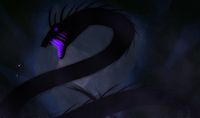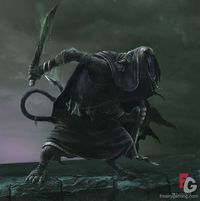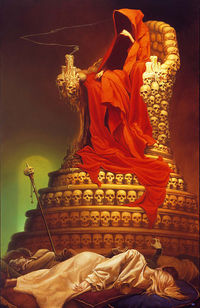Dread Gods
From BelegarthWiki
(→The Great Black) |
(→Elohanna) |
||
| Line 21: | Line 21: | ||
---- | ---- | ||
| − | == | + | ==Apep== |
| − | [[Image: | + | [[Image:Apep.jpg|200px]] |
| − | + | Apep rules over the dark side of the mind, a being of hate, fear, and anger. He is the vengeful spirit of cruelty, the irrational rage of a blood-feud, and the cold stab of terror in the night. His is the mechanical mind of the calculating serial killer, clouded by senselessness and tranquil in madness. He seeks the destruction of civilization and the obliteration of tame society. He kills because she can. | |
| − | + | ||
| − | + | ||
| + | The Temple of the Toxic Lord exists in the stillness of the corpses of the dead, the eerie chill of silence after a great battle. The cultists of Apep are prone to imbibing heavily before and after a day of fighting, using the torpor granted to fuel their murderous calm. They are granted a singular focus in combat and an unfeeling disposition, often sustaining massive wounds without noticing. His dogma appeals to [[Gnoll]] priests, whose ill-tempered dispositions are already well suited to her purpose. | ||
==The Great Black== | ==The Great Black== | ||
Revision as of 01:53, 5 August 2013
The Dread Gods are eldritch war deities from a lost antediluvian age that continue to speak to monstrous priests in the current era. Driven from the Celestial Realms after the Sundering War and weakened by the worship of younger gods, they constantly call for sacrifices to keep up their strength and power. In return for the relentless blood tithe, their followers are granted hideous boons. Although they have no missionaries in any conventional sense, they occasionally compel individuals to further their dark agenda. Those who have been touched by their influence, whether by miasmic visions of death or by the violent handiwork of the faithful, are often driven insane. Their priests are either independant witch-doctors calling upon the ancient traditions of their forefathers or members of The Great Hunt, a militant hunting organization.
In a psychological sense, the Dread Gods represent the primal urges and instincts that cause an individual to kill.
Contents |
The Dogma of Blood and a Creation Myth
"Before Tiamat was split to form the earth, before the sun scorched the wastes, before the genesis of the lesser races, there was a time of monsters and Gods. The Dread Gods are the few who survived the war in the stars, just as the monsters living today owe their ancestry to the violent genocides of our early history." - Yaga Xoshawv
The Tradition of Miasma teaches that before the current era of the lesser races, the world was a primeval place of death, violence, and revelry. The Old Ones, the first of the divine beings, had a loose and shifting pantheon of chaotic entities and the Celestial Realm was in pandemonium. At this time, the lesser races (elves, men, dwarves, etc.) were subservient to the monstrous races (trolls, orcs, goblins, etc.) that used them for fodder and sport. Women used men to satiate their lusts, to build their arching cities, and to solve their petty conflicts. This is the Natural Way, according to the cultists.
The greatest of the Old Ones were the goddesses Tiamat, Shub-Niggurath, and Leviathan. Tiamat was the weaver of reality, continually shifting perception and disrupting the physical laws. Shub-Niggurath, the divine whore, created the first of the mortal races and impulsively pushed all sorts of strange life into existence. Leviathan was the most terrible, swallowing whole planes of existence as an afterthought. Life was nasty, brutish, and short.
Then, without warning, the Old Ones were no more. The Celestial Realm was void of chaos and existence had been chained to order and regulation. Tiamat was split asunder: her torn flesh became the soil and her bones the mountains; her demonic blood soaked the river beds and her vicious mind became the clouds. Shub-Niggurath was wrought, and the vita that spilled from her became the known forms of life. Leviathan was the last slain, and the cavernous space she left became the gateway to oblivion.
The only Old Ones to survive the Sundering War were the Dread Gods, masters of carnage and killing. They fled from the Celestial Realms severely weakened, taking refuge in the torpor of the Miasma. To keep hidden, they have a multitude of forms and avatars, the most common being their wild and warrior shapes. While their worship has been driven to the fringe of religious activity, their insidious power still permeates the domains of reality they rule and is harnessed by those who survive the brutal initiations of their cults.
Apep
Apep rules over the dark side of the mind, a being of hate, fear, and anger. He is the vengeful spirit of cruelty, the irrational rage of a blood-feud, and the cold stab of terror in the night. His is the mechanical mind of the calculating serial killer, clouded by senselessness and tranquil in madness. He seeks the destruction of civilization and the obliteration of tame society. He kills because she can.
The Temple of the Toxic Lord exists in the stillness of the corpses of the dead, the eerie chill of silence after a great battle. The cultists of Apep are prone to imbibing heavily before and after a day of fighting, using the torpor granted to fuel their murderous calm. They are granted a singular focus in combat and an unfeeling disposition, often sustaining massive wounds without noticing. His dogma appeals to Gnoll priests, whose ill-tempered dispositions are already well suited to her purpose.
The Great Black
The Great Black rules the baser instincts and the cunning genius, the hunger behind the teeth and the brilliance of extermination. It is the determination of the hardened hunter, void of doubt. Its methodical path is one of the perfection of adaptability, quietly vicious in its rabid pursuit of any weakness. It kills to serve its own desires.
The Temple of the Black Beast dwells in the tension before a strike and the preparation for conquest. The cultists of the Great Black train rigorously amongst their own, using whatever means available to strengthen themselves and chase excellence. Thusly, these cultists are especially active in The Great Hunt. They are granted the advantage of ability and a nearly psychic foresight, feeling very much at home in the haze of battle. Its dogma appeals to Trolls, and their bodies are covered in the scars from diligent practice of the warrior’s art.
Fie'est
Fie’est claims the subtlety of the shadows and the shine of a keen blade pressing against unsuspecting flesh. He is the grin that haunts the night, snuffing the mortal coil of the unwary or unlucky. His field of expertise is in the killing blow, the release of life from its shabby cell. He observes the release of life with ecstasy and beholds the sight of gore as an intoxicant. He kills for the sheer pleasure.
The Temple of the Hidden Smirk is carried on the death rattle of the dying and rush of excitement in psychotic frenzy. Cultists of Fie’est take the profession of the assassin as an act of worship, delighted by the excuse to indulge in their foul addiction. They use the blood of their victims to make prophecy and take it in a tincture to fend off exhaustion, staying up for days. His doctrine draws shapeshifters, goblins,and those who humour their obscene appetites in obscurity.
Ares
Ares rules the splendour of supremacy and the will to dominance. He is the prideful boasting of the champion and the provocation in a leering taunt. His is the force of bravado carried by talent. Often wrongly interpreted as a god of a lesser race, he is the only Dread God to continue being worshipped in common society, his allure is so strong. He kills to prove his absolute authority and exhibit his skill.
The Temple of the Crimson King lies in the ballads of the victors and in the grand plans of conquest by mighty generals. The cultists of Ares array themselves for every available battle, for songs are not sung of warriors who slept in. They are especially blessed on the field with an abundance of glory, either in triumph or in death. All monstrous and lesser races crave his favour, though few are worthy.




